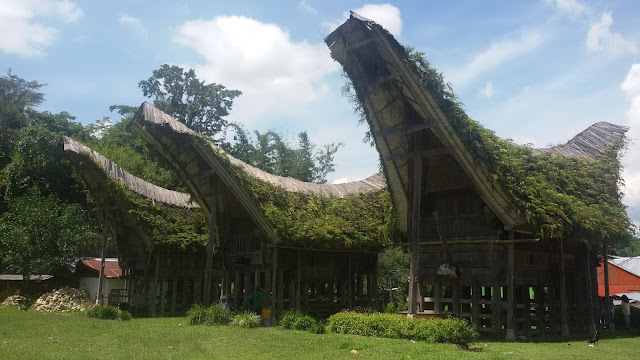Tana Toraja is one of the most intriguing places in Indonesia because it is known for its centuries old rituals of how they celebrate the dead.The regency, as it is referred to, is surrounded by rugged mountains and cliffs all protecting this highland city. The valleys are all filled with lush green fields and coffee plantations. Toraja produces one of the best coffee beans in the world.
 |
| Towering end of a Torajan house |
We visited Toraja on the first week of May although travel blogs recommend to visit the regency during the months of June and July when the most extravagant ceremonies of the dead takes place. Our driver, Pak Tenneng, which we hired from
www.sellatours.com , is a Torajan and is quite knowledgeable of the history of his hometown. He speaks Indonesian though so most of the things I learned during this trip were second-hand translation from my friend.
To sum it up, here are the things I learned about Tana Toraja:
1. When a member of a Torajan family dies (whether a member of a royal or common family, there is a certain law that has to be followed which is implemented by the community leaders. These community leaders will also decide the type of wooden caskets and statues and how many buffaloes or pigs will be used for the ceremony.
2. Wooden statues are made of jackfruit tree and can cost up to 25,000,000 IDR (1,800 USD) to make.
3. If the dead will be placed in a round wooden casket and is a member of the royal family, 24 buffaloes will be offered all at the same time during the ceremony, for a commoner who will be placed in a square wooden casket, 5 buffaloes will be offered. Again this will be determined by the Torajan community leaders.
4. Most of the Torajans are Protestants. Only Protestants, Christians and Catholics follow this death celebration. Muslim Torajan follow the Islamic law.
5. When there is a rooster image or sculpture on top of a church, it means that is exclusively for protestants.
6. When a member of the family dies and they do not have enough money to pay for the ceremonies, bodies of the dead are kept inside the family house, injected with 1-2 litres of formaline to keep it from rotting. Once the family raises the full amount of money, they then start with the celebration. Some families, even if they completed the money to be used for the ceremony, choose to wait for the auspicious months of June and July to celebrate the death.
7. Houses that bear white flags outside indicates that there is a dead body waiting for a ceremony.
8. The use of buffaloes for sacrifice have been done since the time of their ancestors, they can only use buffaloes and pigs for the sacrifice and no other animals as it is what their law says.
9. An albino buffalo, considered to be the holiest and most sacred of all, can cost up to 80,000,000-100,000,000 IDR (6,000-8,000 USD) while regular buffaloes cost 5,000,000-10,000,000 IDR (400-800 USD).
10. For babies who died, they used to have a ceremony of burying the babies inside the trunks of trees but they do not do this anymore. Some of the baby graves can still be visited by tourists in certain parts of the regency.
11. North Torajans and South Torajans have different ways of burial ceremonies. The Southerners bury the dead inside caves while the Northerners bury inside huge rocks.
12. Buffalo fighting only takes place when a member of the royal family dies. The buffalo fighting pit built for the sole purpose of the buffalo fight can only be used once as it is only done for the death ceremony of the member of the royal family.
13. The wooden statues used and placed outside the caves where the South Torajans buried their dead are kept there for good. Members of the family usually replace the clothing on the statues once a year.
14. The Torajan houses where inspired by the design of a boat which sank on a river when it hit a big rock. The pointy ends of the design of these houses must only face the north and south. No Torajan house can be build where both ends are facing the west or east.
15. Torajan houses are usually made of bamboo tree, jackfruit tree, balanda tree and uru trees. Most of them are locally grown but they also use wood from outside the regency.
 |
| Typical Tana Toraja houses converted into guest houses, Toraja Misiliana Hotel |
 |
| Yes it was built more than 4 centuries ago and I slept there. |
 |
| Fine wood carvings decorates the entire house |
 |
| The lower part of this house are used for business. |
 |
| New Torajan house being built |
 |
| The details of the bamboos are just amazing. |
 |
| A local carve man. |
 |
| Caves for the burial of South Torajans. Londa caves |
 |
| Burial caves in Lemo |
 |
| Baby graves in tree trunks. |
 |
| Suaya burial caves. Tombs of the royals. |
 |
| An amazing view from Religi Buntu Buraka peak. |
 |
| The amazing Ke'te Kesu houses and burial caves at the back. |
 |
| at Ke'te Kesu |
 |
| Buffalo market (Bolu Market / Pasar Bolu) |
 |
| Buffalo fighting pit. |
 |
| Burial rock graves in the northern part of Toraja, Batuttumongga. |
 |
| Loko Mata (Rock Burial) in Batutumongga. |
 |
| Megalit Kalimbueng Bori, a Stonehenge looking burial site in the Northern part of Toraja. |
 |
| A morning view in one of the cafes along the road as we leave Tana Toraja. |
--------
15.05.2016













































No comments:
Post a Comment